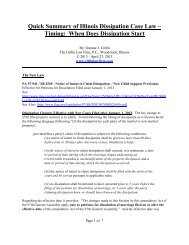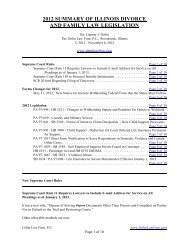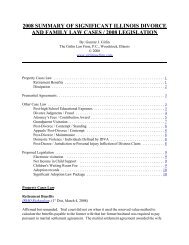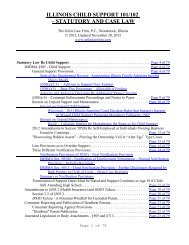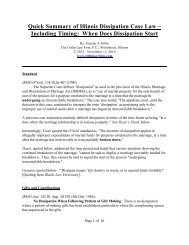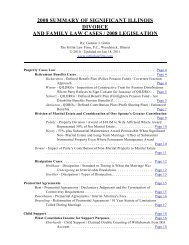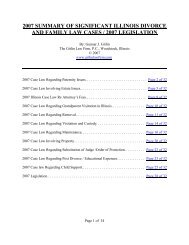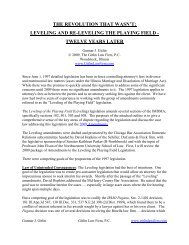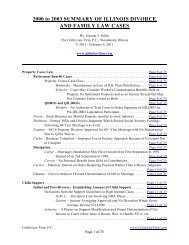child support 101/102 - The Gitlin Law Firm
child support 101/102 - The Gitlin Law Firm
child support 101/102 - The Gitlin Law Firm
Create successful ePaper yourself
Turn your PDF publications into a flip-book with our unique Google optimized e-Paper software.
the Supreme Court’s decision stated:<br />
“<strong>The</strong> Supreme Court could have easily decided to refuse to take cert<br />
on this case. <strong>The</strong>y probably accepted cert knowing that there was a<br />
division among the districts and wanting to clear up the issue.<br />
Unfortunately, after accepting cert and reviewing the record, they<br />
learned that there was nothing to state the nature of the depreciation<br />
expense. Being a conservative judiciary, the court did the proper<br />
thing and refused to suggest by way of broad dictum that had the<br />
expense been justified as reasonable and necessary that the expense<br />
would have been allowed.”<br />
By way of example, Nelson held that the <strong>child</strong> <strong>support</strong> payor was not allowed to deduct farm<br />
equipment depreciation from his net income because he failed to show the expense was an<br />
"expenditure for the repayment of debt." It further held that the <strong>child</strong> <strong>support</strong> payor was not allowed<br />
to deduct payments toward farm operating loan principal from his net income because allowing the<br />
deduction would have permitted the payor use of the same deduction twice.<br />
2. Quantification: Attached are two spreadsheets analyzing certain issues according<br />
to the relevant factors in the statutory and case law. <strong>The</strong> first spreadsheet analyzes<br />
the depreciation elements of the cases and the significant factors. <strong>The</strong> second<br />
spreadsheet analyzes the business expense cases (non-depreciation cases) and the<br />
significant factors.<br />
One opinion, Gay on Behalf of Gay v. Dunlap, is divided into two parts because the determination<br />
of one expense was remanded to the trial court. <strong>The</strong> remainder of the expenses were not allowed.<br />
<strong>The</strong> column regarding "Expense Allowed" refers to those cases in which the expense was ultimately<br />
allowed as a deductible reasonable and necessary business expense as an end result. This includes<br />
cases where the expense was allowed at the trial court level and the result was affirmed, and cases<br />
where the trial court did not allow the expense but there was a reversal.<br />
<strong>The</strong> taxpayer type is not always clear from the opinion. Where it appears relatively clear, the<br />
taxpayer type is set forth. It is clear from the spreadsheet that in most cases the taxpayer is a<br />
Schedule C taxpayer. In only one case was the business incorporated: IRMO Heil. It is probably<br />
not coincidental that this is one of the few cases where at least a portion of the expense was allowed<br />
as a reasonable and necessary business expense.<br />
3. Flowchart re Depreciation Cases: <strong>The</strong> IRMO Davis case presents what can be<br />
illustrated via a flow chart regarding depreciation cases. Note, however, that<br />
especially in light of the Illinois Supreme Court’s Minear case as well as the recent<br />
Worrall case, it appears that the law is not at all fixed as to whether there is an<br />
emphasis on proof of a debt repayment schedule.<br />
a. Debt Repayment Schedule: First determine if there is a debt<br />
repayment schedule.<br />
a. If no Generally non-deductible (but issue not<br />
definitely resolved per Minear/ Worrall)<br />
b. If yes Go to step b.<br />
<strong>Gitlin</strong> <strong>Law</strong> <strong>Firm</strong>, P.C. 1-32 www.gitlinlawfirm.com




